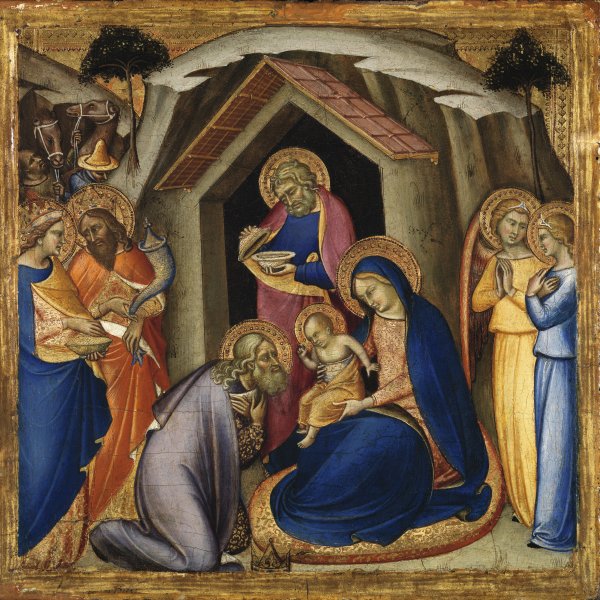The Virgin and Child between Angels and six Saints
This Virgin and Child between Angels and six Saints may have been the central panel of a triptych similar to one now in a private German collection. Niccolò di Tommaso located the Virgin as the central axis of the composition and painted her on a larger scale than the other figures. She holds the Christ Child and both of them look out at the viewer. The Infant Christ’s body is covered with a rich brocade cloth whose colour and design interacts with the piece of cloth that acts as the backdrop to the composition. Christ blesses with one hand while in the other he holds a robin, symbol of the Christian soul and here referring to his future Passion, as according to legend, the robin’s red breast was made by Christ’s blood as the bird tried to pull out a thorn from the crown.
The figures framing the central group are arranged in different tiers in a strictly symmetrical manner. Thus in the top layer we find two angels with their arms crossed. They are followed on the left side by Saint John the Baptist, dressed in his traditional hair shirt and pointing to the Virgin and Child. A deacon saint holds a pen in his hand, while in the foreground we see Saint Bartholomew, identifiable by the knife with which he was skinned. On our right is Saint Anthony Abbot, a saint popularised by The Golden Legend and identifiable by his hooded habit, book and staff with cross-shaped handle; Saint Nicholas, dressed as a bishop with a mitre and crozier; and the Archangel Michael with his sword.
The panel was restored in 1987 at which point the two columns that framed the composition were replaced by the present ones. In addition, two barley-sugar columns attached to the inner edges of the frame were also removed. The Galleria dell’Accademia in Florence has a Coronation of the Virgin by the present artist with a frame similar to this one. The Virgin and Child between Angels and six Saints belonged to the Cremer collection in Dortmund, in whose catalogue it appears as a work by Taddeo Gaddi. When that collection (which was apparently started in the 1860s) was auctioned in Berlin in 1929 the painting was attributed to Nardo di Cione. The painting entered the Thyssen-Bornemisza collection in 1930 and was one of the works selected for the exhibition held in Munich that year. Miklós Boskovits related this painting to two other panels that would complete the hypothetical triptych for which it was designed. They are anAdoration of the Magi (Venice, Galleria Franchetti, Ca’ d’Oro) and a Crucifixion (formerly Schweitzer collection, Berlin).
Mar Borobia









